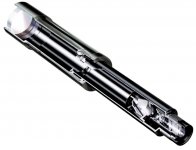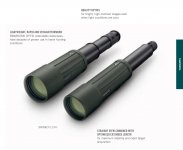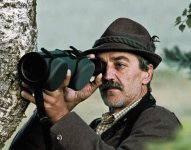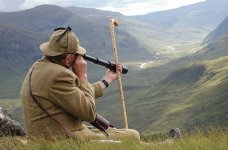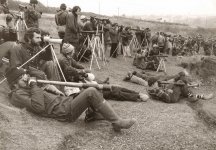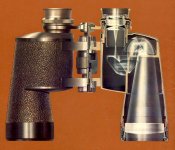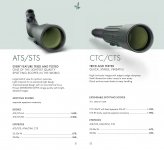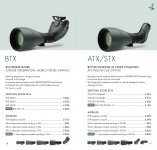-
Welcome to BirdForum, the internet's largest birding community with thousands of members from all over the world. The forums are dedicated to wild birds, birding, binoculars and equipment and all that goes with it.
Please register for an account to take part in the discussions in the forum, post your pictures in the gallery and more.
You are using an out of date browser. It may not display this or other websites correctly.
You should upgrade or use an alternative browser.
You should upgrade or use an alternative browser.
CTC 30x75 question? (1 Viewer)
- Thread starter Northman
- Start date
More options
Who Replied?I would be surprised it had any play at all anywhere. I would also be surprised one would need 2 hands to focus it -- the focusing happens at the eyepiece, and you need the other hand on the body (if you are not using a tripod). The drawbacks I see are: (1) extended is pretty long, (2) no HD glass, (3) and finally, minimum focusing distance is 10 metres. I find (3) a complete show stopper for me. It is designed for hunters, who do not need a spotter at 10 metres or less, but I watch birds and wildlife way, way more than I hunt.
John A Roberts
Well-known member

Perhaps of interest to some . . .
The CTC 30x75 which dates from 2001, is the most recent version of a series of draw tube telescopes from Swarovski that date back to 1967!
Optically, it’s a classic fixed lens external focus design. It consists of a cemented achromat objective, a Schmidt-Pechan prism pair and an eyepiece in what appears to be a 1, 1, 2, 1 configuration (or perhaps with a 2 element first group?). Focusing is by moving the prism and eyepiece groups in tandem, in relation to the objective (contrast this to many Porro prism binoculars, where the eyepiece group moves in relation to the fixed objective and prism groups).
While the CTC will have a sharp central image, it won’t be sharp to the edges in the same way as the ATX/ STX series with their more complex field flattener eyepieces. And while it doesn’t have HD glass, it’s less necessary than in many other telescopes, due to the lack of optical complications associated with having an internal focus lens moving between the front objective lenses and the prisms.
Like Swarovski’s traditional pattern Porro prism binoculars, their draw tube telescopes also benefit from the use of current coating technologies. In a 2013 catalogue (the last which has transmission data for all of the telescope lines), the CTC’s transmission is listed as 84%. In comparison, the interchangeable lens CTS, along with the the ATS/ STS series and the ATX/ STX series, are all listed at either 85 or 86%.
- - - -
More history and technical information about the Swarovski draw tubes can be found at: Swarovski Habicht CT-75 20-60 Value?
And comments from users can be found at: Advantage of drawscope over fixed-length spotting scope if total length is the same?
And also at: CTS 30x75 or CTS 85?
- - - -
Some more images:
• the double draw/ interchangeable lens CTS 85, and the single draw/ fixed lens CTC 30x75
• use with a tree for a rest, from Swarovski (stubble optional?)
• using a draw tube unit with a hiking stick for support while sitting (I can no longer locate the source)
• using a long multi-draw unit while supine!, from Very British Twitchers
And a review of the earlier interchangeable lens CT 85 and CT 75 versions by Steven Ingraham of Better View Desired
John
The CTC 30x75 which dates from 2001, is the most recent version of a series of draw tube telescopes from Swarovski that date back to 1967!
Optically, it’s a classic fixed lens external focus design. It consists of a cemented achromat objective, a Schmidt-Pechan prism pair and an eyepiece in what appears to be a 1, 1, 2, 1 configuration (or perhaps with a 2 element first group?). Focusing is by moving the prism and eyepiece groups in tandem, in relation to the objective (contrast this to many Porro prism binoculars, where the eyepiece group moves in relation to the fixed objective and prism groups).
While the CTC will have a sharp central image, it won’t be sharp to the edges in the same way as the ATX/ STX series with their more complex field flattener eyepieces. And while it doesn’t have HD glass, it’s less necessary than in many other telescopes, due to the lack of optical complications associated with having an internal focus lens moving between the front objective lenses and the prisms.
Like Swarovski’s traditional pattern Porro prism binoculars, their draw tube telescopes also benefit from the use of current coating technologies. In a 2013 catalogue (the last which has transmission data for all of the telescope lines), the CTC’s transmission is listed as 84%. In comparison, the interchangeable lens CTS, along with the the ATS/ STS series and the ATX/ STX series, are all listed at either 85 or 86%.
- - - -
More history and technical information about the Swarovski draw tubes can be found at: Swarovski Habicht CT-75 20-60 Value?
And comments from users can be found at: Advantage of drawscope over fixed-length spotting scope if total length is the same?
And also at: CTS 30x75 or CTS 85?
- - - -
Some more images:
• the double draw/ interchangeable lens CTS 85, and the single draw/ fixed lens CTC 30x75
• use with a tree for a rest, from Swarovski (stubble optional?)
• using a draw tube unit with a hiking stick for support while sitting (I can no longer locate the source)
• using a long multi-draw unit while supine!, from Very British Twitchers
And a review of the earlier interchangeable lens CT 85 and CT 75 versions by Steven Ingraham of Better View Desired
John
Attachments
Last edited:
CharleyBird
Well-known member

There's a used CTC drawscope for sale at Aceoptics if anyone's interested, graded Mint-
I just received an Optolyth Mini 25x70, which works on the same principle but has a minimum focal distance of approx 5 metres, wide angle. It packs small, it is reasonably light, it is slow to focus (but it takes just one hand), no slop. I can hold it acceptably steady by hand alone, using a walking stick as a monopod should work well (not tried). I do not think it replaces my STS 80 HD on a purposeful visit to a hide or a well known birding place, but for a walk in the woods packing limited weight and limited gear I already much prefer it. I might settle on it or add/replace it with a Meopta TGA 30x75 at some point, but as someone doing more hiking than going to set birding spots I should have gotten a drawscope earlier.
tenex
reality-based
Why wouldn't one have used Porro prisms in a design like this; are they not compact enough for the inner draw tube? And why would the transmission still be only 84%?It consists of a cemented achromat objective, a Schmidt-Pechan prism pair and an eyepiece in what appears to be a 1, 1, 2, 1 configuration (or perhaps with a 2 element first group?).
I've always wanted a CTC just for its classic design, but keep resisting.
John A Roberts
Well-known member

Hi tenex,
You raise two interesting points.
As I indicated, the main external housing only contains the objective glass, while the rear focusing portion contains both the prisms and the eyepiece. What I didn’t make clear, is that focusing is by helical rotation of the rear assembly - not just sliding it back and forth.
So the problem with using Porro prisms is the necessary offset of the objective and eyepiece axes. With a stationary main objective housing, focusing the rear assembly, would cause the eyepiece to revolve around the axis of the objective lens pair e.g. see an image of a CZJ Octarem, to help illustrate the point.
It’s courtesy of Holger at: Zeiss: Collection of cross-section and cutaway images
Having said that, I’d be unsurprised if someone, somewhere, sometime had made a draw tube telescope with Porro prisms.
- - - -
And while it’s not necessarily of practical significance, it is hard to understand the fractionally lower transmission of the CTC.
Firstly, one would not expect the fixed magnification eyepiece to have more surfaces (lens groups) than the two zoom eyepieces for the CTS.
And both the S and X series scopes have additional glass surfaces due to:
• internal focusing with more complex objectives (5 lenses in 3 groups: 2, 1 plus 2 focusing elements), and;
• non-optical glass plates for airtightness, one at the rear of the main housing and another at the front of the eyepiece *
* the eyepiece mount on the CTS is also fitted with a non-optical glass plate (and the CTS uses the same eyepieces as the S series).
It may be that the 84% is a 'marketing percentage'. The folks there might have looked at the spec’s and said:
'So you’re telling us that the one that’s by far and away the cheapest, performs better than the others? Well that’s not going to help higher end sales!'
e.g. see some pages from a current export pricing brochure, with prices in €
. . . So perhaps we should read the transmission figure as '84% and more'?
And FWIW, the most recent technical data sheets dating from 2020, show the transmission for:
• the ATX/ STX is now 90%, while;
• the ATS/STS is still 86%;
(the sheets for the CTC and CTS don’t have transmission figures).
John
p.s. I too have long found the idea of the classic CTC alluring!
You raise two interesting points.
As I indicated, the main external housing only contains the objective glass, while the rear focusing portion contains both the prisms and the eyepiece. What I didn’t make clear, is that focusing is by helical rotation of the rear assembly - not just sliding it back and forth.
So the problem with using Porro prisms is the necessary offset of the objective and eyepiece axes. With a stationary main objective housing, focusing the rear assembly, would cause the eyepiece to revolve around the axis of the objective lens pair e.g. see an image of a CZJ Octarem, to help illustrate the point.
It’s courtesy of Holger at: Zeiss: Collection of cross-section and cutaway images
Having said that, I’d be unsurprised if someone, somewhere, sometime had made a draw tube telescope with Porro prisms.
- - - -
And while it’s not necessarily of practical significance, it is hard to understand the fractionally lower transmission of the CTC.
Firstly, one would not expect the fixed magnification eyepiece to have more surfaces (lens groups) than the two zoom eyepieces for the CTS.
And both the S and X series scopes have additional glass surfaces due to:
• internal focusing with more complex objectives (5 lenses in 3 groups: 2, 1 plus 2 focusing elements), and;
• non-optical glass plates for airtightness, one at the rear of the main housing and another at the front of the eyepiece *
* the eyepiece mount on the CTS is also fitted with a non-optical glass plate (and the CTS uses the same eyepieces as the S series).
It may be that the 84% is a 'marketing percentage'. The folks there might have looked at the spec’s and said:
'So you’re telling us that the one that’s by far and away the cheapest, performs better than the others? Well that’s not going to help higher end sales!'
e.g. see some pages from a current export pricing brochure, with prices in €
. . . So perhaps we should read the transmission figure as '84% and more'?
And FWIW, the most recent technical data sheets dating from 2020, show the transmission for:
• the ATX/ STX is now 90%, while;
• the ATS/STS is still 86%;
(the sheets for the CTC and CTS don’t have transmission figures).
John
p.s. I too have long found the idea of the classic CTC alluring!
Attachments
Last edited:
William Lewis
Wishing birdwatching paid the bills.

I've been using a ctc 75 for birding for the last couple of years. It's great. The view through it I find to be perfectly satisfactory, it's helped me I'd a lot of birds I wouldn't have stood a chance at without a scope and the relatively large objective coupled with the relatively low magnification means its nice and bright. I was sitting on brancaster beach with it on a small monopod a few weeks back looking at great skuas a good distance off shore and a red throated diver slightly closer to the shore with no problem at all, tide way out.
The best thing about it is its a decent 30x mag optic thats mega portable. I found that with a full size scope and the inevitable large tripod they require that even with a rucksack style tripod holder thingy I just tended to leave them at home most of the time.
With the ctc you can just sling it and a small monopod in a satchel and go.
Another bonus is in hides, I'm sure we've all been there, not wanting to bother dismounting the scope from the tripod to attach it to the hide clamp so standing stooped at the back of a hide trying to peer through a letter box 2 meters away, not so the ctc, just rest it on the edge of the window, top tip, works best resting with your hand on the vertical surface of the window so you can adjust the height to eye level easily.
I did use it for a while just as was with no monopod which is fine most of the time as there's usually something about to rest it on but have since been using it with a monopod, just for ease of use, no point using one with a tripod, kinda defeats the point.
I know many scopes with tripods are probably better optically and for long duration comfort but if it isn't easily to hand (shoulder strap, covers on to looking at a bird is about 6 seconds with the ctc) then what's the point when the birds probably flown off.
It works for me but as I've never seen anyone else birding with a draw tube having been at it for 30 years I'm definitely in the minority!
The best thing about it is its a decent 30x mag optic thats mega portable. I found that with a full size scope and the inevitable large tripod they require that even with a rucksack style tripod holder thingy I just tended to leave them at home most of the time.
With the ctc you can just sling it and a small monopod in a satchel and go.
Another bonus is in hides, I'm sure we've all been there, not wanting to bother dismounting the scope from the tripod to attach it to the hide clamp so standing stooped at the back of a hide trying to peer through a letter box 2 meters away, not so the ctc, just rest it on the edge of the window, top tip, works best resting with your hand on the vertical surface of the window so you can adjust the height to eye level easily.
I did use it for a while just as was with no monopod which is fine most of the time as there's usually something about to rest it on but have since been using it with a monopod, just for ease of use, no point using one with a tripod, kinda defeats the point.
I know many scopes with tripods are probably better optically and for long duration comfort but if it isn't easily to hand (shoulder strap, covers on to looking at a bird is about 6 seconds with the ctc) then what's the point when the birds probably flown off.
It works for me but as I've never seen anyone else birding with a draw tube having been at it for 30 years I'm definitely in the minority!
Similar threads
Users who are viewing this thread
Total: 2 (members: 0, guests: 2)





